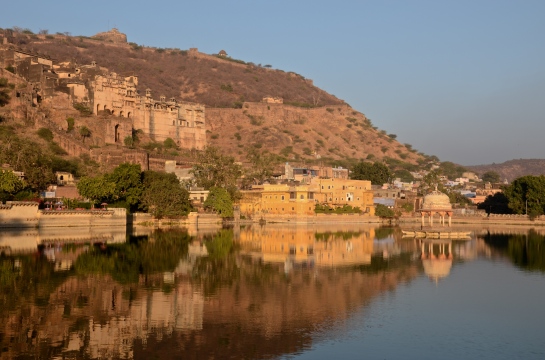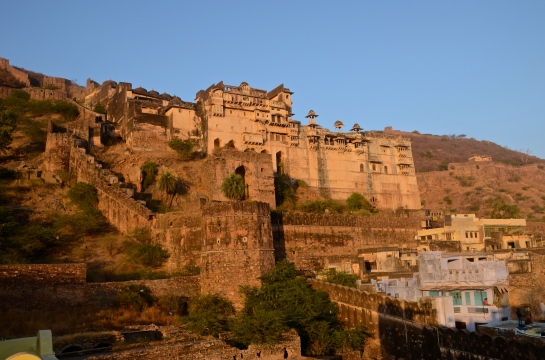
Arriving in Bundi the last day of the kite festival, the sky was littered with paper kites. We all know how the Indians love a festival and this one was no exception. We climbed up the hill at sunset to watch the multi colored kites fluttering high above the blue city.

For a couple of years we’d heard interesting things about Bundi: not only does it have a magnificent Rajput palace, but it also has a pretty lake and the town is scattered with old havelis in various degrees of decay. Never more than a modest market center, according to our guidebook, Bundi has stayed relatively untouched by modern development. We stayed just inside the town walls in one of the havelis converted to a guesthouse, the top floor with magnificent views.

We ate our evening meal on the roof terrace looking toward the palace lit up in an orange glow. At breakfast we sat in an alcove up among tree branches, leaves rustling in the breeze filtering the morning sunshine over the lake.

A colorful bazaar stretched the length of a narrow thoroughfare;

narrower side streets climbed up toward the palace.

It was easy to spend a whole day at the Palace. It is one of the few in Rajasthan whose style has not been influenced by the Moghuls.

Entering through a main gateway adorned with carved elephants, we could wander quite freely among the many rooms and courtyards.

The palace is known for its superb collection of murals. Indeed the paintings were perhaps the best we’ve yet seen in India, all in surprisingly good condition, with limited graffiti or evidence of vandalism. For a little baksheesh, a local with a set of keys was more than happy to unlock the maharani’s dressing room. Every surface of her chamber was covered in finely detailed miniatures, embellished with gold and silver leaf. “Photography not allowed”. The Chittra Sala, the courtesan’s quarters, faced a lush garden. Murals in unusual turquoises, blues and blacks portrayed scenes from the life of the blue faced Krishna.

It was here we met a young Sikh couple from the Punjab. They described to us how they’d met via an online dating service, a common practice among young Indians today. Using filters, they find a partner with similar background, lifestyle and values. In the case of this couple, most critical was finding someone also in the Sikh religion.

Over chai they told us stories of the Rajasthani rulers. Historically, the relationship between the Maharaja and his people was like father and son. They may not have liked each other very much or had anything in common, but were still bound by reciprocal bonds. Taxes supported the extravagant lifestyle of the rulers. On the other side of the coin, when there was a marriage in the village, the raja would send gifts of money; when there was a death, the wood for the funeral pyre would be provided by the palace. Government was embodied in a single person whose actions conformed to tradition. This was possible because of the small size of the Rajas’ kingdoms.
“Size,” the young Sikhs said , “is one of India’s chief problems: it brings distance and impersonality. In the days of the Maharaja you could go to him and tell him your difficulties, and if they were genuine he would do everything he could to help you. But in modern day India, you have to meet with some clerk in a government office for every little thing.”

O ur Sikh friends told us it was Guru Gobind Singh’s birthday – there’s always something to celebrate in India. They invited us to go to the free langar at the Gurudwara. We thanked them, but there was still more of the palace we wanted to see. In the evening, a loud commotion brought us out on the street. We watched a parade of tractors pulling trailers filled with waving Sikhs, ranging from the young to the very old, all on their way to Gurudwara. They’d come in from the country for the festival.
ur Sikh friends told us it was Guru Gobind Singh’s birthday – there’s always something to celebrate in India. They invited us to go to the free langar at the Gurudwara. We thanked them, but there was still more of the palace we wanted to see. In the evening, a loud commotion brought us out on the street. We watched a parade of tractors pulling trailers filled with waving Sikhs, ranging from the young to the very old, all on their way to Gurudwara. They’d come in from the country for the festival.
As we were packing up to leave, we both agreed Bundi was a place we could easily return to.
Another place to put on our list when we return.
LikeLike
You would love it. Join us in 2017
LikeLike
I make a note about Bundi, especially because of the absence of Moghul influence
LikeLike
We think you’d love it. Join us there in 2017?
LikeLike
Superb. Thank you so much for sharing. What pleasant karma you have with India…xo, lots of love, cw
LikeLike
Thanks Bobbi. Inspiring photos. Enjoy your blog immensely. Happy Trails, Toland
>
LikeLike
Wow. Nice photos!
LikeLike
I’m really enjoying your blog! Beautiful writing and photos. Makes me long to return to India…
LikeLike
Dear Bobbi and Gerard, Wonderful photographs! Rajasthan has a blue city as well as a pink city (Ganganagar). I imagine that there are even more colors awaiting you. Dr. Michael Mayo-Smith’s parents used to go to Rajasthan as tourists whereas most of us went only to see Sant Ji. Now I understand the draw of Rajasthan as a touring destination! What a beautiful place it appears to be in your pictures. We are not having satsang tomorrow morning because a big snow storm has hit the northeastern United States. We will resume the following week. Remember to be on the look-out for news of Gobind Singh during your travels in India. I very much look forward to the next chapter of your blog! With love and best wishes, – Richard S.
>
LikeLike
Sent from my iPhone Bobby hello you too I’m dictating this so I don’t know if it’s going to work or not I’ve had trouble with this this machine but anyway I’ve been following you have it I have had trouble with this phone and and a few other health issues but hopefully I’m betting about to, I’ve been following you to the Bundy in Pushaw
> On Jan 21, 2016, at 2:29
> AM, A Small Case Across India .com> wrote: > > >
LikeLike
Lovelywrite up! Surely bundi is not for everyone. Only those who appreciate the finer details and willing to look beyond the obvious!
LikeLike
thanks.! we loved Bundi. This year plan to explore m ore of Rajasthan including BIkaneer and Kuchaman
LikeLiked by 1 person
I’m sure you’ll love bikaner. In all likelihood, Junagarh is the best museum in India showcasing the life of royalty. Where are you based, btw e
LikeLike